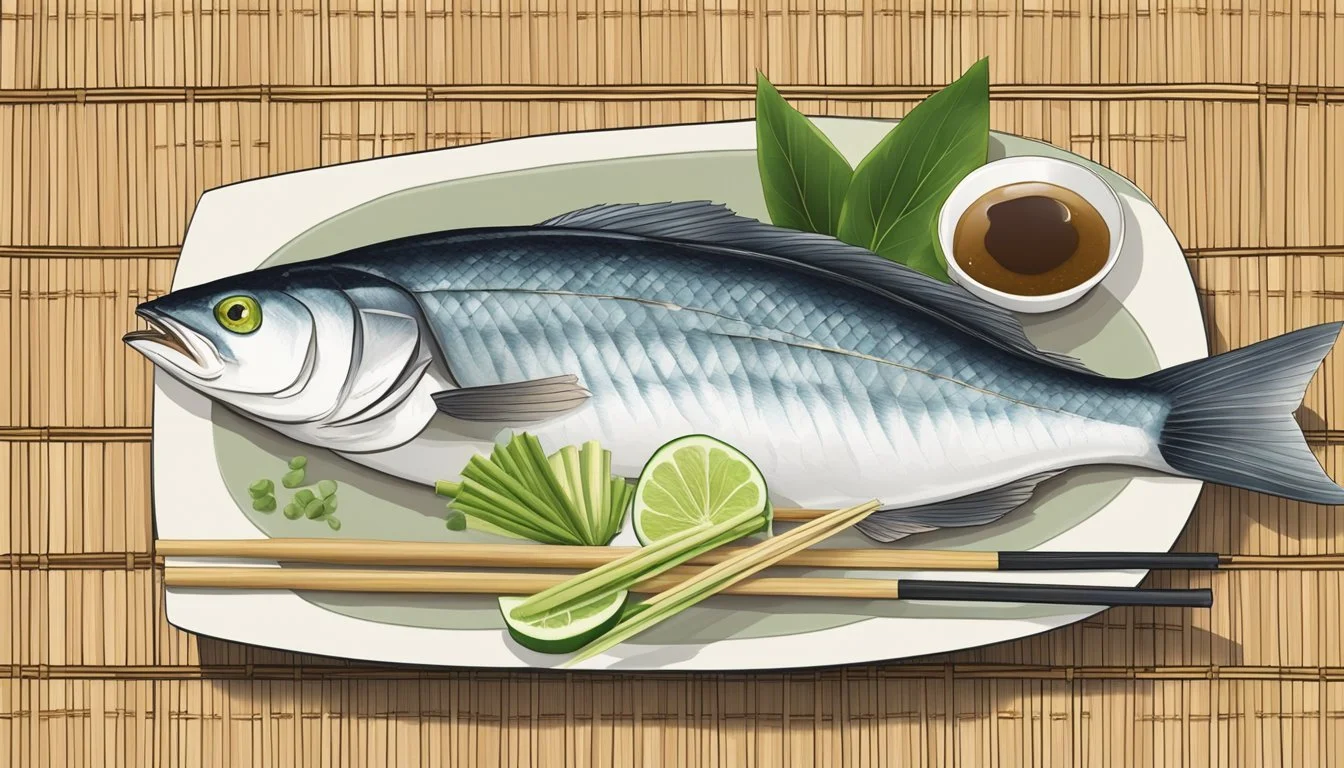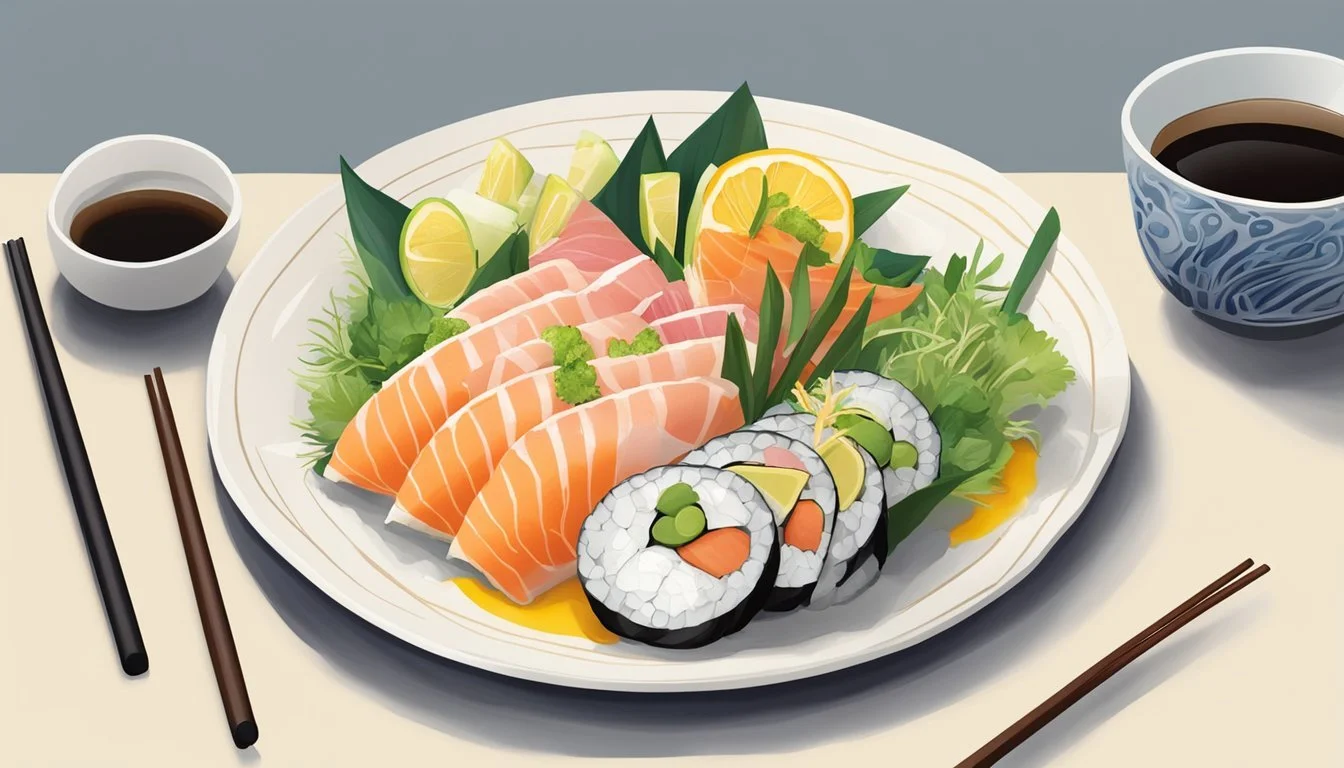How do You Eat Yellowtail Sashimi?
Mastering the Art of Enjoying this Delicacy
Yellowtail sashimi is a delicacy in Japanese cuisine known for its rich, buttery taste and a staple in the world of sushi. (What wine goes well with sushi?) It involves fresh slices of yellowtail fish (What wine goes well with fish?), also referred to as Japanese Amberjack, Hamachi, or Buri, usually served raw and without rice. This fish is characterized by its high oil content, contributing to a smooth texture that is often described as melting in the mouth. While it can be enjoyed with minimal garnishing, the simplicity of the dish allows the intrinsic flavor of the yellowtail to shine through.
Eating yellowtail sashimi is an experience that emphasizes taste and texture, with particular attention paid to the way the fish is cut and presented. Typically sliced into thin, bite-sized pieces, yellowtail is often served with soy sauce or a variety of dipping sauces to complement its flavor. Some preparations may feature additional garnishes like sliced jalapeño or shiso leaves to enhance the dish's taste profile. The freshness of the fish is paramount, as it impacts both the taste and the safety of consuming it raw.
The way one enjoys yellowtail sashimi can vary, but a common method includes taking a piece of the fish, lightly dipping it in soy sauce – being careful not to overwhelm the fish's natural flavor – and then consuming it in a single bite. This allows for an appreciation of the delicate texture and the subtle interplay of flavors between the fish and any chosen accompaniments. Each bite of yellowtail sashimi offers a burst of ocean freshness, making it a must-try for enthusiasts of seafood and sushi.
Understanding Yellowtail Sashimi
Yellowtail Sashimi is a traditional Japanese dish featuring thin slices of raw yellowtail fish, prized for its delicate flavor and buttery texture. This section will guide you through the essentials of yellowtail sashimi and its nutritional benefits.
What Is Yellowtail Sashimi?
Yellowtail Sashimi refers to Hamachi or Buri—terms for young and mature yellowtail fish, respectively. The fish is carefully selected for its freshness and quality, prepared as thinly-sliced servings, commonly enjoyed with condiments such as soy sauce. It is a species of jack and is often farm-raised, especially the varieties served in the US and Japan.
Nutritional Profile
Yellowtail is not only celebrated for its taste but also its nutritional content. A serving of yellowtail sashimi provides a significant source of protein, essential for muscle repair and maintenance. Here is an overview of its nutritional profile per 100 grams:
Nutrient Amount Calories 146 kcal Protein 23 g Fat 5 g
The fish is relatively low in calories while being rich in protein, making it a suitable addition to various diets focused on lean protein intake.
Preparation Essentials
In the art of serving yellowtail sashimi, the preparation process is vital. This includes selecting the highest quality fish, using proper equipment, and mastering the technique of slicing to ensure the best possible flavor and texture.
Selecting Quality Fish
The success of yellowtail sashimi begins with choosing the freshest sushi grade yellowtail fish. Look for a vibrant color, firm texture, and a clean, oceanic smell. The fish should have clear eyes and bright red gills, clear indicators of freshness. Fish safety is paramount; thus, always source yellowtail from reputable suppliers who adhere to food safety standards.
Required Equipment
A well-equipped kitchen is essential for preparing sashimi. One needs a sharp knife specifically designed for sashimi, like a Yanagiba or a Sashimi Bocho, to achieve those perfect cuts. The knife must be kept razor-sharp at all times. Other necessities include a sturdy cutting board that won't slip and appropriate plating to present the sashimi.
Knife Skills for Slicing
Proper knife skills are crucial for preparing yellowtail sashimi. One should slice the fish against the grain into clean, uniform pieces, ideally about 1/4 inch thick. Maintaining a consistent angle and pressure, they make smooth, decisive cuts without sawing. A sharp knife is not just about ease but also preserving the fish's delicate texture and enhancing its natural flavor.
Traditional Japanese Serving
When serving yellowtail sashimi, or hamachi, in the traditional Japanese style, it's essential to consider the accompaniments and garnishes that enhance the flavor, as well as the precise techniques of plating the sashimi.
Accompaniments and Garnishes
Hamachi, or Japanese amberjack, is typically served with a selection of accompaniments that include soy sauce for dipping, wasabi paste to add a spicy kick, and pickled ginger to cleanse the palate between bites. The addition of lemon wedges is also common, providing a citrusy accent that can brighten the taste of the fatty fish.
Soy Sauce: A small bowl for dipping.
Wasabi: Freshly grated or in paste form, placed directly on the plate for diners to use at their discretion.
Ginger: Thinly sliced pickled ginger serves as a palate cleanser.
Lemon: Optional wedges or slices for a citrusy zest.
These elements are arranged neatly alongside the fish slices to allow diners to customize each bite according to their preferences.
Serving Techniques
Yellowtail sashimi is presented with attention to detail that reflects the Japanese cultural emphasis on aesthetics. Chefs slice hamachi against the grain into uniform pieces—about 1/4 inch thick—to ensure a pleasing texture. These slices may be draped over shiso leaves or laid on a bed of thinly shredded daikon radish for visual appeal and a subtle flavor contrast.
Shiso Leaves: Used as a base, adding a hint of minty and basil-like flavor.
Daikon Radish: Shredded for a crisp, refreshing bed beneath the sashimi.
The arrangement of the sashimi is simple yet deliberate, often fanning out in a decorative pattern that invites the diner to appreciate the beauty of the dish before tasting. A traditional Japanese serving of hamachi takes into account not just the flavors but also the visual harmony of the plate.
Cultural Variations
Yellowtail sashimi is celebrated worldwide, and its preparation varies across cultures, incorporating distinct flavors and styles. These cultural interpretations often retain the essence of sashimi while showcasing local tastes and ingredients.
Italian Style Yellowtail
In Italy, yellowtail sashimi, or "crudo," marries the tradition of raw fish with a zest of Mediterranean flair. Olive oil, revered in Italian cuisine, is a key ingredient, lending its rich, fruity essence to the delicate yellowtail. Fine slices of yellowtail are often drizzled with a high-quality olive oil and topped with aromatic ingredients like minced garlic or freshly cracked black pepper. The flavor profile is further enhanced by a squeeze of citrus, typically lemon, but sometimes yuzu, an Asian citrus that is gaining popularity in modern Italian kitchens. The result is a nuanced dish that respects the integrity of sashimi while embracing the robustness of Italian culinary traditions.
Modern Fusion Interpretations
Fusion cuisine brings innovative twists to yellowtail sashimi, integrating diverse culinary concepts. In many modern restaurants, chefs might garnish yellowtail slices with thinly sliced jalapeño, introducing a subtle heat that contrasts the fish's buttery taste. The presence of yuzu ponzu sauce is another hallmark of modern adaptations, providing a complex, tart flavor that balances the richness of the sashimi. This sauce often combines yuzu with ponzu—a tangy Japanese condiment—infused with hints of ginger and sometimes garlic, creating a garlic ponzu sauce that adds depth to each bite. The use of these bold, yet balanced sauces and garnishes exemplifies the inventive spirit of contemporary fusion cooking and its impact on the traditional sashimi experience.
Customizing Your Sashimi Experience
Yellowtail sashimi offers a versatile canvas for flavors and spices, allowing for a personalized taste journey. Considering dietary needs can also shape how one indulges in this delicate dish.
Adding Flavors and Spices
When enhancing the natural, subtle taste of yellowtail, fresh accompaniments and bold spices can be employed. One can place a thin slice of jalapeño atop each piece for a burst of heat or drizzle with ponzu sauce, a mixture of soy sauce, citrus juice, and yuzu, to balance the dish with a tangy note. Minced garlic and sesame oil can introduce a depth of flavor, adding to the umami experience. Carefully measured dashes of spice and sweeteners such as sugar can also be used to adjust flavor profiles to one's preference.
Condiments Description Pairing Suggestion Jalapeño Adds heat Complements fatty fish well Ponzu Sauce Soy sauce with citrus infusion Perfect for adding zest Minced Garlic Gives an aromatic, sharp taste Use sparingly for depth Sesame Oil Introduces a nutty, rich umami quality A few drops enhance flavor Yuzu Japanese citrus, offers a distinct tart flavor Balances out the dish's taste
Dietary Considerations
Those adhering to specific dietary restrictions can still relish yellowtail sashimi by choosing appropriate accompaniments. For instance, individuals managing their sodium intake may opt for low-sodium soy sauce or smaller amounts of seasoning. For guests seeking gluten-free options, ensuring that all sauces—like soy sauce or pre-made spice mixes—are certified gluten-free is essential. Sashimi fits well within keto or low-carbohydrate diets, as it is predominantly protein and can be served without rice. To accommodate all guests, providing a variety of condiments allows each person to adjust their dish to meet their dietary preferences while enjoying the nuanced flavor profile of yellowtail.
Remember, the key to customizing sashimi lies in the careful selection and use of spices and flavors, tailoring the experience to one's individual taste and dietary needs without overshadowing the yellowtail's naturally rich flavor.
Sashimi Presentation and Etiquette
When serving yellowtail sashimi, the presentation is as essential as the quality of the fish. It reflects the Japanese culinary tradition of simplicity and respect for the ingredients.
Plating Techniques
Yellowtail sashimi is often presented in odd numbers to adhere to Japanese aesthetic principles. The slices should be thin and consistent, arranged neatly on the plate. Nobu-style sashimi, a method popularized by chef Nobu Matsuhisa, often features garnishes like thinly sliced jalapeno. To elevate the dish for a dinner party, chefs may layer slices of lemon or radish beneath the sashimi for both visual appeal and flavor enhancement.
A common garnish is daikon radish, cut into fine strands for a delicate texture contrast. It's not uncommon to see the addition of artistic shapes or designs using the radish to complement the natural beauty of the fish.
Dining Etiquette
Participants in a sashimi meal should start by cleaning their hands with a wet towel provided by the restaurant. Chopsticks are the preferred utensil, and soy sauce should be used sparingly to not overpower the subtle taste of the sushi-grade yellowtail. It is polite to consume each piece in a single bite. Enjoying yellowtail sashimi is about savoring the natural flavors, and therefore heavy condiments are typically avoided.
Storing and Handling Leftovers
When dealing with leftover yellowtail sashimi, fundamental food safety practices should guide storage procedures. Sashimi, being a delicate seafood, requires careful attention to maintain its quality and ensure it is safe for consumption.
Immediate Refrigeration: To minimize bacterial growth, any uneaten yellowtail sashimi should be refrigerated promptly within 2 hours of serving. This is essential to keep the fish safe for later consumption.
Leftovers Storage Recommendations:
Temperature: Store in the fridge at 40°F or below.
Container: Wrap tightly or place in an airtight container.
Ice Pack: Utilize an ice pack within the container if possible.
Duration: Consume within 3 days to ensure quality and safety.
If there are uncertainties regarding the timeframe of when the sashimi was initially served, err on the side of caution and discard any questionable leftovers.
Reviving Leftovers: Leftover sashimi can be gently seared if one prefers not to consume it raw after its initial serving. To sear, one should briefly cook the fish on both sides until it reaches a golden brown color. Add a splash of soy sauce for flavor if desired. This transforms the sashimi into a new dish while mitigating some risks associated with raw leftovers.
Adhering to these guidelines is not just about preserving taste but also crucial for preventing foodborne illnesses. Hence, when in doubt, it's prudent to discard any portion that does not align with these guidelines of leftover management.
Health and Safety Considerations
When consuming yellowtail sashimi, it is crucial to consider food safety to prevent foodborne illness. Yellowtail, a saltwater fish, is typically safer to eat raw than freshwater species, which may harbor parasites. Additionally, the term sushi-grade signals that the fish has been frozen to temperatures that kill parasites, making it suitable for raw consumption.
The preparation environment for yellowtail sashimi should be clean and well-maintained. Equipment such as knives and cutting boards must be sanitized thoroughly to prevent cross-contamination. It is advisable to use specific equipment dedicated to handling raw fish.
Here are key safety measures to follow:
Freezing: Ensure yellowtail has been frozen to the appropriate temperatures, as prescribed by food safety guidelines, to kill parasites.
Hygiene: Handlers should wash their hands and use clean utensils when preparing sashimi.
Storage: Store yellowtail at safe temperatures, right until preparation, to minimize bacterial growth.
Cross-Contamination: Avoid using the same equipment for raw and cooked foods without proper sanitation.
Purchasing fish from reputable sources that adhere to regulatory standards for labeling and handling raw fish can significantly reduce health risks. Consumers should also be attentive to any advisories about seafood consumption to stay informed on the potential risks associated with raw fish.
Pairing with Drinks and Sides
When enjoying yellowtail sashimi, choosing complementary drinks and sides enhances the overall dining experience. The delicate flavors of the fish are well-paired with sides that offer a balance of texture and taste, as well as drinks that don't overpower the sashimi's subtlety.
Drinks:
Sake, a traditional Japanese alcohol, is often served chilled to accompany sashimi. Its range from dry to sweet can be paired according to personal preference.
Green tea provides a bitter counterpoint that complements the oily richness of yellowtail.
Light, citrus-infused beers or a crisp white wine can also be refreshing partners to the dish.
Sides:
A garnish of shredded daikon offers a crunchy and refreshing contrast to the smooth sashimi.
Citrus yuzu ponzu sauce, with its tangy flavor profile, acts as a dressing that heightens the delicate taste of the fish without masking it.
Sides such as a dollop of tobiko (flying fish roe) or masago (capelin roe) add a pop of both color and salty, oceanic flavor.
Incorporate various Japanese sauces carefully:
Soy citrus yuzu ponzu sauce, a blend of soy sauce and citrusy yuzu, can be lightly drizzled over the sashimi.
A sparing amount of eel sauce may be used, offering a sweet and savory glaze that can complement the yellowtail's flavor without overwhelming it.
One should enjoy these pairings mindful of the balance between the main dish and the accompaniments, ensuring that the delicate yellowtail always remains the star of the meal.
Exploring Recipes Beyond Sashimi
Yellowtail, a versatile seafood ingredient, effortlessly transitions from classic sashimi to a variety of Japanese and globally-inspired dishes. The rich flavor of yellowtail lends itself to diverse cooking techniques and flavor profiles, expanding the culinary horizon for enthusiasts of this fish.
Yellowtail-Based Dishes
Beyond its raw sashimi form, yellowtail can be the star in a myriad of other recipes. A Nobu-style preparation involves slicing yellowtail thinly and accenting with jalapeno slices, a method that enhances the fish's flavor with a gentle heat. For a more substantial dish, one can incorporate yellowtail into a roll, such as the Negihama Maki, which combines finely cubed yellowtail with scallions, rolled in sushi rice and nori.
Another option is to explore the Japanese concept of donburi, where cooked yellowtail is paired with rice. A Miso-Marinated Hamachi Bowl represents such a dish, with the fish marinated in a blend of mirin, sake, soy sauce, and miso, combining the essence of Japanese cuisine with the comfort of a heartier meal.
Creative Culinary Ideas
Chefs and home cooks can get creative by integrating yellowtail into various cooked preparations. Yellowtail cubes can be simmered in a pot with a miso-based broth, ginger, and vegetables to create a comforting soup. Another idea is to marinate the fish in a mixture of ginger, soy sauce, and citrus juice before grilling, yielding a harmonious balance between charred notes and the innate delicacy of the fish.
When working with yellowtail in cooked recipes, remember to consider the fish's natural oil content – it has a higher fat content that keeps it moist during cooking and adds a luxurious texture to the finished dish. Whether one decides to grill, bake, or incorporate it into soups and stews, yellowtail remains a celebrated mainstay of seafood cuisine, extending far beyond the familiar sashimi platter.
Conclusion
Yellowtail sashimi is a quintessential item in Japanese cuisine and can serve as a delicate appetizer or part of a larger meal for lunch or dinner. Its signature buttery texture makes it a favored choice for those who appreciate the subtleties of raw fish dishes. (What wine goes well with raw fish dishes?) When consuming yellowtail sashimi, diners revel in the simplicity and the natural flavors of the fish, often enhanced only by minimal garnishes and sauces.
The ideal approach to eating yellowtail sashimi is to relish each slice individually, possibly with a light dip in soy sauce, aligning with the Japanese aesthetic of savoring the purity of the ingredients.
Note on Pairing:
Soy Sauce: A common pairing to contrast the richness of the fish.
Wasabi: Optional, gives a burst of heat that accentuates the dish's flavors.
Pickled Ginger: Often served on the side to cleanse the palate between bites.
In summary, yellowtail sashimi offers a sophisticated experience that combines both taste and tradition. It is a dining choice that speaks to the elegance of minimalism in culinary arts, where the high-quality ingredient—yellowtail—takes center stage.








